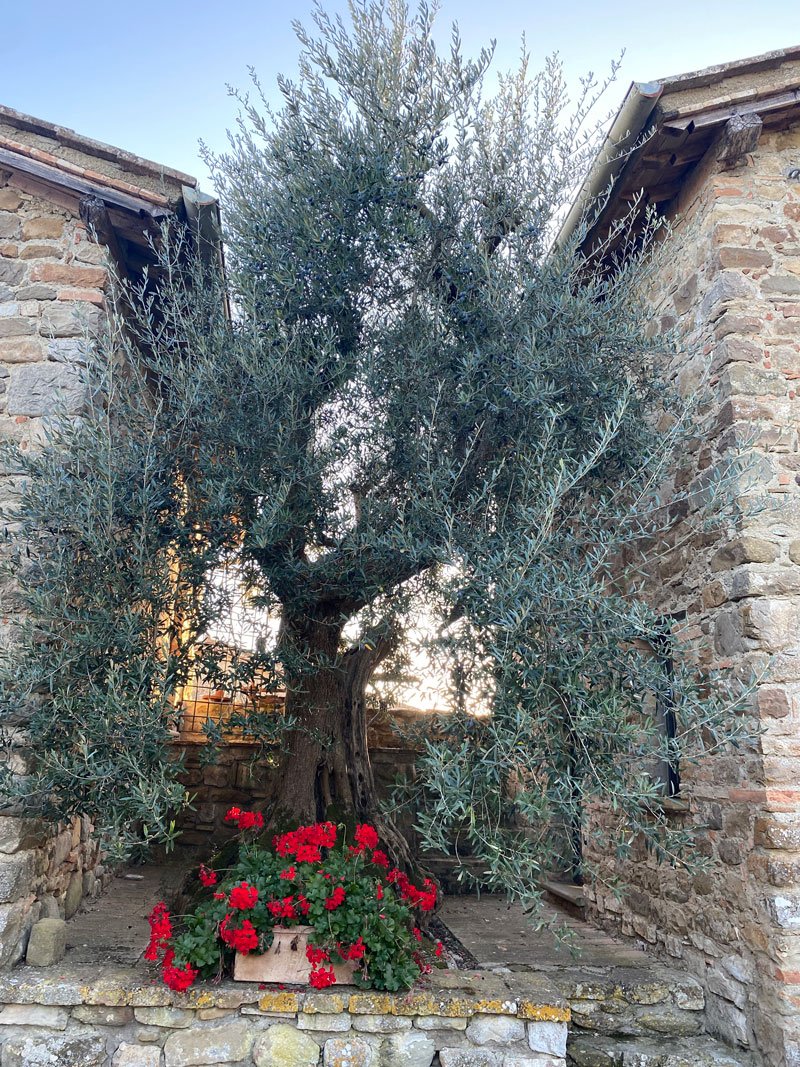Almost every plant at Montemigiano has been purposefully cultivated for hundreds of years. According to Angelo, the Italian patriarch of the town, the pool terrace was once a magnificent vegetable garden, and lavender and rosemary bushes still form aromatic hedges. A variety of grapes are grown here, and wine from the vineyard down the hill tastes like this place.
An abundance of trees provide precious shade, producing cherries, pomegranates, figs, chestnuts, and olives. This seasonal cornucopia has sustained generations of families, and when the rains are favorable, it is as beautiful as it is bountiful.
The oldest olive tree at Montemigiano is nestled in the courtyard of Casa di O’liovo, named for the impressive tree that is so old the house was built around it.
Normally, the age of a tree can be proven with some margin of error thanks to dendrochronology. (Dendrochronology inspects the tree rings within a tree’s trunk in order to estimate its’ age.) However, olive trees are so old, their inner structures have deteriorated to the point where it’s impossible to accurately tell their age. But scientists think the oldest olive trees alive today are 6,000 years old. Located in Lebanon, The Sisters of Noah are a grove of 16 trees that still produce olives.
The Borgo di Montemigiano has exactly 42 mature olive trees. I know this because my girlfriends and I are currently enjoying a girls trip and we are here helping our Italian friends with the Raccolta delle Olive (Olive Harvest). For almost three decades, I’ve visited this magical place in the spring and summer but never the fall. This time of year quickly became my favorite due to the cooler temperatures, lack of tourists, ample parking, and available restaurant reservations.
Montemigiano boasts several varieties of olive trees, each with their own unique personality. Most of the olives will be turned into oil at the communal town press with a percentage of the oil "donated" back to the press where it is sold at markets and in shops to offset costs.
The large green olives are pitted and stuffed with meat, then breaded and fried in a recipe borrowed from Southern Italy called ‘Olive all’ Ascolana’ named for the town where it originated. Although Italians are fiercely regional about their culinary specialties, these hearty treats are so beloved that they are enjoyed throughout Italy.
Olive Harvesting
There are four ways to harvest olives:
1. Brucatura
This is the traditional method where the olives are harvested by hand and it is undoubtedly the best in terms of the quality of oil produced because neither the olives nor the ramoscelli (twigs) are damaged. The downside is that it’s very labor intensive and time consuming.
2. Bacchiatura
This involves beating the branches of the tree with a bastone (stick) or canna (cane) to make all the mature olives fall off. This method is often used if the tree is too big to make collection by hand practical.
3. Scuotitura
Scuotere in Italian means to shake, but the shaking in this case is done by machines, which are attached to the trunk causing the tree to vibrate and the olives to fall. This method would only really be used by big commercial growers due to the cost of the machinery involved, but it’s more cost effective than hand picking.
4. Cascola naturale
This is the least labor-intensive method because the olives are just left to fall off the tree in their own, but the quality of the oil produced this way is very poor.
The method we're using is Brucatura, hand collection with a rastrellini, a small curved rake used to gently scrape off the olives.
The Raccolta delle Olive feels more like a meditative celebration than work, with lively conversations in at least three languages, and the obligatory break for pranzo a mezzogiorno (lunch at midday) featuring bread dipped in olive oil from last year's harvest.



